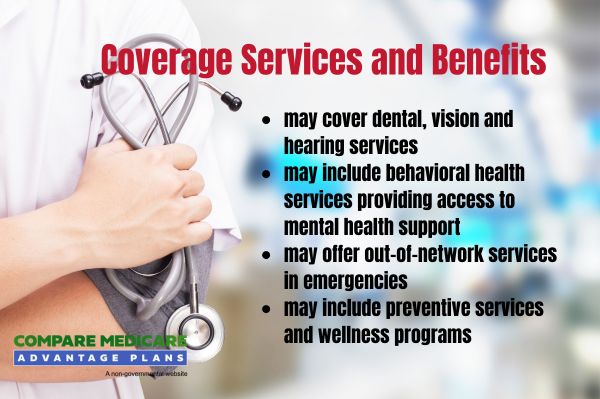Medicare Advantage Plans Florida 2026
Curious about the potential Medicare Advantage plans in Florida
Key Takeaways
- Enrollment in Medicare Advantage plans can be done online or via phone, and understanding coverage details and possible costs could be crucial for maximizing benefits.
- Medicare Advantage plans offer various options, including HMO, PPO, and SNPs, each designed to meet different healthcare needs and preferences.
- Some Medicare Advantage Plans in Florida may provide additional benefits that could go beyond Original Medicare, such as vision, dental, and hearing coverage.
Compare Plans in One Step!
Enter Zip Code
Understanding Florida Medicare Advantage Plans for 2026

Medicare Advantage plans, also known as Part C, are private insurance options that provide Medicare benefits. Some of these plans may offer additional services not covered by traditional Medicare, such as dental, vision, and hearing coverage. This comprehensive approach to healthcare likely means that beneficiaries could potentially receive more holistic care that addresses a wider range of health needs.
Medicare Advantage plans likely provides transparency around coverage criteria, which could aid beneficiaries by clarifying the available services. This means that members could get a better understanding of what may be covered, helping them make more informed decisions about their healthcare.
Types of Florida Medicare Advantage Plans Available
Medicare Advantage plans will likely offer a variety of options to meet the diverse needs of beneficiaries. These options are primarily categorized into Health Maintenance Organization (HMO) plans, Preferred Provider Organization (PPO) plans, and Special Needs Plans (SNPs). Each type of plan is designed to cater to different healthcare needs and preferences, providing flexibility and choice for enrollees.
HMO Plans
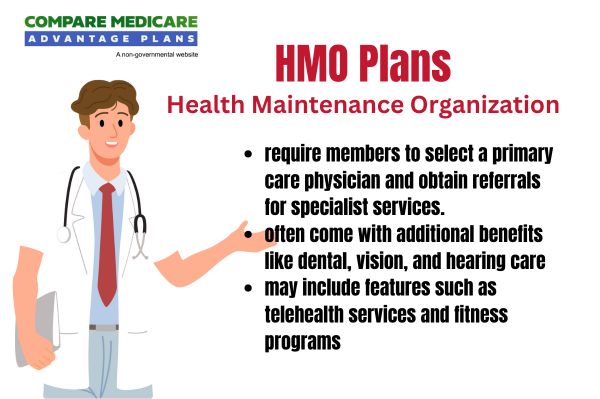
HMO plans are structured to require members to select a primary care doctor who coordinates all their care and provides referrals for specialists. This model likely ensures that all healthcare services are streamlined through a single point of contact, which could enhance the coordination and quality of care. Moreover, these plans might offer lower premiums and out-of-pocket costs compared to other types of Medicare Advantage plans, possibly making them a cost-effective option for many beneficiaries.
However, HMO plans often have a network of doctors and hospitals that members must use to receive full benefits. This means that while the costs might be lower, the choice of healthcare providers may be more restricted. Beneficiaries must weigh the trade-offs between potential cost savings and provider flexibility when choosing an HMO plan.
PPO Plans
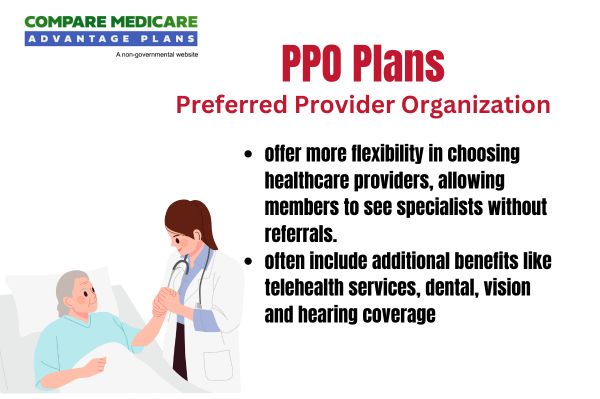
PPO plans provide more flexibility in choosing healthcare providers, allowing members to see any doctor or specialist without needing a referral. This could be particularly advantageous for those who prefer direct access to specialists or have specific healthcare needs that require frequent specialist visits. PPO plans typically have a network of preferred providers, but they also allow members to choose out-of-network providers at a higher cost.
Monthly premiums for PPO plans may vary widely and may be higher compared to other types of Medicare Advantage plans. However, some plans might include additional benefits such as vision and dental coverage, which may not be available in other plan types.
Special Needs Plans (SNPs)
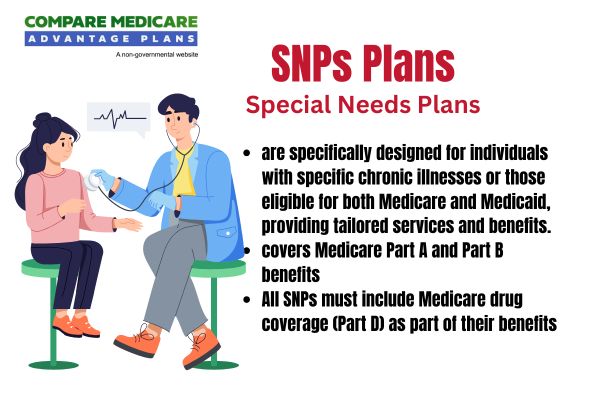
Special Needs Plans (SNPs) are designed to provide targeted care for specific populations, such as those with chronic conditions or dual eligibility for Medicare and Medicaid. These plans could offer tailored benefits to meet the unique healthcare requirements of individuals with special needs, possibly ensuring they receive comprehensive and specialized care.
Covered Services and Potential Benefits
Medicare Advantage plans must follow specific regulations that dictate the minimum benefits they must provide, aligning closely with original Medicare coverage requirements. This likely ensures that beneficiaries receive a baseline level of care that meets their essential health needs.
By entering their zip code into the Plan Finder Tool on this website, beneficiaries can view provider network information more easily, aiding in informed decision-making regarding their health care options.
Possible Benefits of Florida Medicare Advantage Plans
Some Medicare Advantage plans may provide additional benefits not included in Original Medicare, such as vision and dental coverage, possibly making them an attractive option for many beneficiaries. These additional services could potentially enhance the overall healthcare experience, likely addressing needs that go beyond basic medical care.
Some Medicare Advantage plans could potentially offer lower out-of-pocket costs compared to traditional Medicare. This could make healthcare more affordable, particularly for those on a fixed income.
Members could potentially benefit from a maximum out-of-pocket limit, which helps protect them from high medical expenses. This financial protection could provide peace of mind, knowing that there may be a cap on how much they could spend on healthcare each year.
Enrollment Process for Florida Medicare Advantage Plans
To enroll in a Medicare Advantage Plan, individuals must have Medicare Part A and Part B and reside in the service area of the chosen plan. This ensures that beneficiaries are eligible for the coverage provided by the Medicare Advantage plan.
The enrollment process involves selecting a plan that fits their healthcare needs and preferences. To enroll, call one of our licensed agents at 1-833-641-4938 (TTY 711), Mon-Fri 8 am-9 pm EST.
When to Enroll
The Initial Enrollment Period for new Medicare recipients lasts for seven months: three months before, the month of, and three months after qualifying for Medicare. This period provides ample time for individuals to explore their options and make an informed decision about their Medicare Advantage plan. Enrollment typically begins three months before turning 65, includes the month of turning 65, and continues for three months after that month.
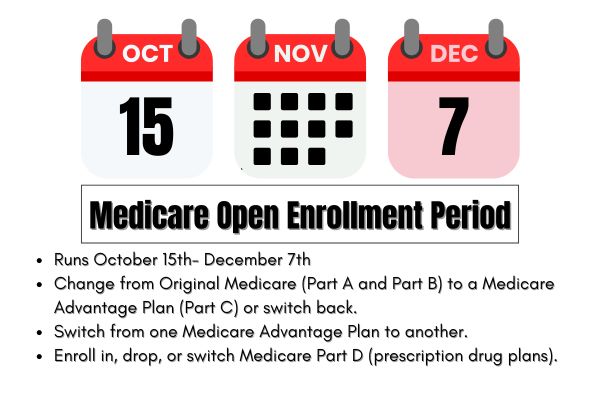
Individuals under 65 who qualify due to disabilities can enroll after 24 months of receiving Social Security Disability Insurance, ensuring they have access to Medicare Advantage benefits.
Different Enrollment Periods
There are specific enrollment periods such as the Open Enrollment Period from October 15 to December 7, during which beneficiaries can join, switch, or drop Medicare Advantage plans. This period allows beneficiaries to review their current plan and make changes if necessary to better suit their needs.
The General Enrollment Period occurs annually from January 1 to March 31 for those who missed their initial signup. Special Enrollment Periods are available for individuals who experience qualifying events, such as moving to a new area or losing other health coverage.
These periods provide flexibility for beneficiaries to adjust their plans based on life changes and ensure continuous coverage.
OEP, AEP, Special Enrollment
The Medicare Advantage Open Enrollment Period runs from January 1 to March 31, allowing those already enrolled to switch plans or revert to Original Medicare. This period provides an opportunity for current enrollees to evaluate their plan and make adjustments if their healthcare needs have changed.
The Annual Enrollment Period (AEP) occurs from October 15 to December 7, during which individuals can enroll in, switch, or drop Medicare Advantage plans.
Special Enrollment Periods (SEPs) allow for enrollment changes outside the standard periods under specific circumstances, like relocation or loss of current coverage. These flexible enrollment options ensure that beneficiaries can always find a plan that meets their needs.
Possible Costs Associated with Medicare Advantage Plans

Medicare Advantage plans may involve out-of-pocket costs, which may include premiums, deductibles, coinsurance, and copayments. These potential costs could vary significantly based on the specific plan chosen and the services utilized.
Understanding these costs could be crucial for beneficiaries to budget effectively for their healthcare expenses.
Premiums and Co-Pays
Premiums for Medicare Advantage plans may vary annually and will likely be determined by the specific plan selected. In addition to premiums, beneficiaries may also face co-payments and deductibles that could change based on their plan’s structure.
Out-of-Pocket Maximums
Some Medicare Advantage plans may incorporate cap on out-of-pocket costs. This potential limit may include all co-pays and deductibles for covered services, possibly ensuring that beneficiaries do not spend beyond this amount annually.
This potential out-of-pocket limit could help protect seniors from excessive healthcare costs, possibly ensuring that they can access necessary medications without financial hardship.
Covered Services and Possible Benefits
Medicare Advantage plans must cover all essential health services typically provided under Medicare Part A and Part B. This could help ensure that beneficiaries receive comprehensive healthcare coverage that meets their basic medical needs. In addition to standard benefits, certain Medicare Advantage plans may also offer additional services like vision, dental, and hearing care.
Medicare Advantage plans may also impose various cost-sharing structures, such as copayments and coinsurance, for covered services.
How to Qualify for a Medicare Advantage Plan
To qualify for a Medicare Advantage plan, one must be enrolled in both Medicare Part A and Part B. Eligibility also requires residing within the plan’s designated service area. These basic requirements ensure that beneficiaries are eligible for the coverage provided by the Medicare Advantage plan.
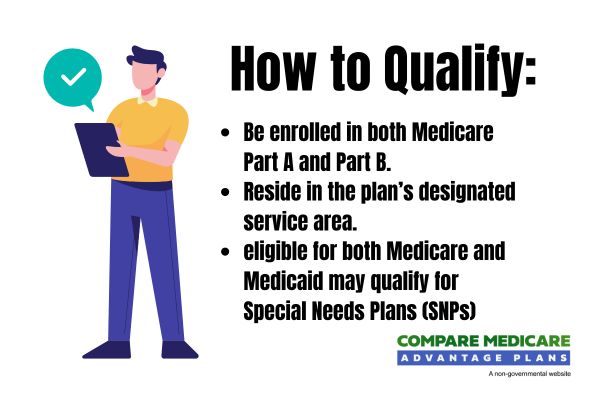
Individuals can apply for Medicare Advantage plans during specific enrollment periods, including the Annual Enrollment Period from October 15 to December 7. There are also opportunities to switch Medicare Advantage plans during the Medicare Advantage Open Enrollment period from January 1 to March 31.
Special Enrollment Periods may be available for qualifying events, allowing changes outside standard enrollment windows.
Contracted Network and Access to Care
Medicare Advantage plans must ensure a network of providers that adequately meets the needs of their enrolled population. Regional preferred provider organizations (RPPOs) might offer care outside their network under certain conditions with CMS approval.
For private fee-for-service (PFFS) plans, network areas will likely be determined based on where at least two network-based plans operate. The Centers for Medicare & Medicaid Services (CMS) publishes updates regarding network areas applicable for future contract years. This likely ensures that beneficiaries have access to a robust network of providers.
Comparing Florida Medicare Advantage Plans to Original Medicare
Medicare Advantage plans are required to offer at least the same level of coverage as Original Medicare, but may include additional benefits not available in Original Medicare, such as vision, hearing, and dental coverage.
These potential benefits could make Medicare Advantage plans an attractive option for many beneficiaries.
Potential Coverage Differences
Unlike Original Medicare, some Medicare Advantage plans may provide additional coverage for services like vision, dental, and hearing care. Medicare Advantage plans will likely have specific provider networks, while Original Medicare allows patients to visit any doctor or hospital that accepts Medicare. This could potentially offer more flexibility in choosing healthcare providers.
Medicare Advantage plans are mandated to cover all services that Original Medicare offers, but they could impose different cost-sharing and payment structures. Certain plans may provide a limit on certain out-of-pocket costs, unlike Original Medicare, which does not have a cap. This could potentially provide financial protection against high medical expenses.
Cost Comparisons
Some Medicare Advantage plans may have lower premiums than Original Medicare but might have higher out-of-pocket costs for certain services. Prescription drug coverage could vary significantly between Medicare Advantage plans and Original Medicare, as some Medicare Advantage plans may incorporate prescription drug coverage into their plans. While some Medicare Advantage plans may also offer lower premiums, enrollees still need to pay their Part B premium.
Cost-sharing structures, such as co-pays for particular services, may vary significantly between Medicare Advantage plans and Original Medicare. Some Medicare Advantage plans may offer additional benefits, like vision and dental care, possibly making Medicare Advantage plans a cost-effective option for many beneficiaries.
Emergencies and Referrals

Medicare Advantage plans typically require prior authorization for non-emergency specialist visits and certain services. It’s essential for members to understand their plan’s specific referral requirements to avoid unexpected costs. Plans may have different rules regarding referrals for specialists, which could affect access to timely care.
In emergencies, beneficiaries can seek care from any provider without prior authorization. Some plans may also offer an urgent care, allowing access to necessary care without a referral.
Summary
Medicare Advantage plans in Florida
As you consider your healthcare options, it’s important to understand the different types of Medicare Advantage plans available, their possible costs, and the potential benefits they might offer. By making informed decisions, you can ensure that you receive the best possible care and support for your health and well-being.
Frequently Asked Questions
→ What types of Medicare Advantage plans are available?
Medicare Advantage plans include Health Maintenance Organization (HMO) plans, Preferred Provider Organization (PPO) plans, and Special Needs Plans (SNPs). Understanding these options could help you choose the right plan for your healthcare needs.
→ When can I enroll in a Medicare Advantage plan?
You can enroll in a Medicare Advantage plan during the Initial Enrollment Period, the Annual Enrollment Period from October 15 to December 7, the General Enrollment Period from January 1 to March 31, or during Special Enrollment Periods for qualifying events. It’s essential to be aware of these timeframes to ensure you have coverage.
→ What are the possible costs associated with Medicare Advantage plans?
Some Medicare Advantage plans might involve various costs such as premiums, deductibles, coinsurance, and copayments.
→ How do Medicare Advantage plans compare to Original Medicare in terms of coverage?
Medicare Advantage plans provide at least the same coverage as Original Medicare, but some plans may incorporate additional benefits like vision, dental, and hearing care. This could make Medicare Advantage plans an appealing option for many beneficiaries seeking more comprehensive health coverage.
→ What should I do in an emergency situation with a Medicare Advantage plan?
In an emergency, you can seek care from any provider without prior authorization, bypassing network restrictions. It’s essential to utilize urgent care benefits when available, as many plans do not require referrals in these situations.

ZRN Health & Financial Services, LLC, a Texas limited liability company


